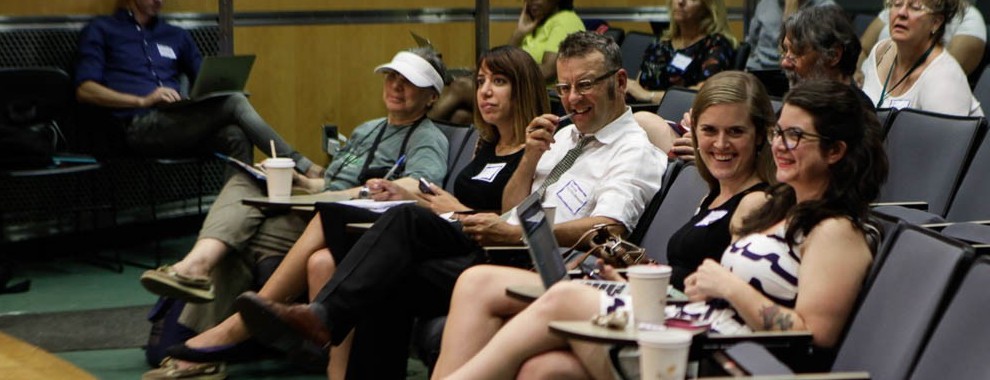On July 15, over 120 journalists, editors and people passionate about building online communities came to ONACamp Toronto to discuss audience engagement and video. Featuring a well-rounded roster of experts from Canada and the United States, the day was full of inspiring conversation and useful takeaways for newsrooms thinking about how to better serve their audiences.
We’ve collected presentations for the day, audio and some of our favorite insights here. You can also check out #ONACamp on Twitter for more from the crowd. A big thanks to everyone who was tweeting takeaways from ONACamp and sharing examples from their own newsrooms. Even as the industry invests more heavily in audience engagement and video, it’s clear there are so many unique approaches — it was so useful to get insights into how newsrooms in Canada are thinking about reaching their communities in meaningful ways.
Special thanks to Ryerson University for hosting, ONA Toronto for supporting the event and The Gannett Foundation for being a longtime funder of ONACamps.
[soliloquy slug=”onacamp-toronto”]Understanding the role of the Engagement Editor
What does an Engagement Editor do? Racked’s Annmarie Dooling says there isn’t really a standard for the job — from organizatipon to organization, and even day to day, it changes. For Rogers Media’s Lindsey Weibe, there’s a strong focus on equipping digital editors with the tools they need to do better storytelling on social platforms. For both editors, there is a strong focus on how to balance what action to take based on data newsrooms collect about what readers are doing and how to organize “softer” engagement campaigns. Across the board, editors in this position are at the forefront of thinking about community and how to best reach them, respond to them and get them to take action on a story.
Heartily agree with @TravelingAnna that Engagement Eds need varied skill sets (graphics, SEO, video etc.) Not just Twitter monkeys! #ONAcamp
— shauna rempel (@ShaunaRempel) July 15, 2016
How not to break the bank with video
For newsrooms looking to invest more heavily oin video, Angela Pacienza and Patrick Dell’s tips from The Globe and Mail’s are crucial. Hear about projects that cost the newsroom more than expected, how they learned from those experiences and readjusted their approach. The gear and platforms for shooting video may have changed, but basic principles of good video production haven’t. Thinking through the story you want to tell in advance, editing as you go, encouraging your staff to shoot often are all important. Dell and Pacienza share workflows and tools useful for freelancers, journalists in small newsrooms and video nerds alike.
What to include in a digital video pitch, according to @patrickdell #ONAcamp pic.twitter.com/cNTRxyK11P
— Lisa Varano (@lisareports) July 15, 2016
Targeting social messages by platform
People are often surprised when Neil Solanky points out that NowThis doesn’t have a homepage, but when he shares its social impact — 13 million social followers and 2.3 billion views — he gets journalists’ attention. When creating for social, he says the number one thing to remember is that platforms have a purpose. Make sure the story you’re creating fits the tone for its posting destination and also matches what people are looking for there.
Instead of focusing on what does well on social and trying to replicate that, look at what didn’t work well and learn from that. #ONACamp
— Victoria Ahearn (@VictoriaAhearn) July 15, 2016
Managing Breaking News and User-Generated Content
In breaking news situations, you’ll always find hoaxes and rumors. Buzzfeed Canada’s Craig Silverman encourages you to be aware and careful. He also has a slew of tips and tools to help verify content on social medias so you can be sure the information you’re reporting is accurate.
This, this, this! RT @mgirouar: This is always important to remind ourselves #ONAcamp #journalism #ethics pic.twitter.com/vkUTwzAPa9
— Peg McNichol (@indiepeg) July 15, 2016
Using analytics to inform your storytelling
Kenny Yum is passionate about getting news organizations to start thinking beyond a basic approach to analytics. For Yum, metrics can better guide your editorial strategy and give clear insights on how your newsrooms should be measuring successes. Think about the business question you are tying to answer when deciding which metrics to prioritize at your organization. For all newsrooms, time is one of the most important things to consider and can help provide context for other analytics.
So many metrics. But necessary to get the whole picture of performance on all platforms. #ONACamp (Via @yumke) pic.twitter.com/AYj6Kam1wV
— shauna rempel (@ShaunaRempel) July 15, 2016
Using the Google Newslab Tools
Samaruddin Kassim Stewart from the Verified Pixel Project gave an overview of Google’s tools aimed at journalists, identifying specific ones to help you research stories, fact-check figures, find what’s trending and locate and visualize useful datasets. Learn more about advanced Google Search techniques and refinements, Google Trends, Google Public Data Explorer, Google Earth and more in his presentation.
More tips
For more tips, check out the #ONAcamp tag on Twitter. If you’re passionate about audience engagement, we’re planning lots for you at ONA16 in Denver, Sept. 15-17.
My cup runneth over with knowledge from #ONACamp. Need to take some time to digest and process. Likely with a glass of wine.
— Meagan Kashty (@MegKashty) July 16, 2016

